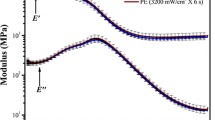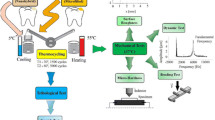Abstract
Light activated composites are the most popular choice in the field of dental restoration. They generally show internal stress even after a prolonged time period. The knowledge of mechanical properties and residual stress should provide interesting information on the clinical performance of such materials. Accordingly, in the current research experimental analyses were carried out to assess the effect of the curing process on the properties of one of the most commonly employed light activated dental composites (Gradia Direct—GC Corporation, Japan). At 10 min, 1 h and 24 h after light curing, the bending modulus (4.7–6.2 GPa) as well as the punching performance (peak load of 12.1–17.5 N) were evaluated for the micro-hybrid composite. Scanning electron microscopy also allowed to analyze the fracture surface. Residual stresses ranging from 0.67 ± 0.15 MPa to 1.12 ± 0.17 MPa were measured by means of the thin-ring-slitting approach reported in the literature, according to measurement time and cutting time.




Similar content being viewed by others
References
De Santis R, Gloria A, Maietta S, Martorelli M, De Luca A, Spagnuolo G, Riccitiello F, Rengo S (2018) Mechanical and thermal properties of dental composites cured with CAD/CAM assisted solid-state laser. Materials 11(4):504. https://doi.org/10.3390/ma11040504
De Santis R, Gloria A, Prisco D, Amendola E, Puppulin L, Pezzotti G, Rengo S, Ambrosio L, Nicolais L (2010) Fast curing of restorative materials through the soft light energy release. Dent Mater 26:891–900
Versluis A, Tantbirojn D, Douglas WH (2004) Distribution of transient properties during polymerization of a light-initiated restorative composite. Dent Mater 20:543–553
Versluis A, Tantbirojn D, Pintado MR, De Long R, Douglas WH (2004) Residual shrinkage stress distributions in molars after composite restoration. Dent Mater 20:554–564
Davidson CL, de Gee AJ, Feilzer A (1984) The competition between the composite–dentin bond strength and the polymerization contraction stress. J Dent Res 63:1396–1399
Eick JD, Welch FH (1986) Polymerization shrinkage of posterior composite resins and its possible influence on postoperative sensitivity. Quintessence Int 17:103–111
Ferracane JL, Mitchem JC (2003) Relationship between composite contraction stress and leakage in Class V cavities. Am J Dent 16:239–243
Park JW, Ferracane JL (2006) Residual stress in composites with the thin-ring-slitting approach. J Dent Res 85(10):945–949
Uno S, Asmussen E (1991) Marginal adaptation of a restorative resin polymerized at reduced rate. Scand J Dent Res 99:440–444
Kemp-Scholte CK, Davidson CL (1990) Complete marginal seal of Class V resin composite restorations effected by increased flexibility. J Dent Res 69:1240–1243
Alkhiary YM, Morgano SM, Giordano RA (2003) Effect of acid hydrolysis and mechanical polishing on surface residual stresses of low-fusing dental ceramics. J Prosthet Dent 90:133–142
Condon JR, Ferracane JL (1998) Reduction of composite contraction stress through non-bonded microfiller particles. Dent Mater 14:256–260
Taskonak B, Mecholsky JJ Jr, Anusavice KJ (2005) Residual stresses in bilayer dental ceramics. Biomaterials 26:3235–3241
Yoshikawa T, Burrow MF, Tagami J (2001) The effects of bonding system and light curing method on reducing stress of different C factor cavities. J Adhes Dent 3:177–183
Braga RR, Hilton TJ, Ferracane JL (2003) Contraction stress of flowable composite materials and their efficacy as stress-relieving layers. J Am Dent Assoc 134:721–728
Ferracane JL (2005) Developing a more complete understanding of stresses produced in dental composites during polymerization. Dent Mater 21:36–42
Witzel MF, Calheiros FC, Goncalves F, Kawano Y, Braga RR (2005) Influence of photoactivation method on conversion, mechanical properties, degradation in ethanol and contraction stress of resin based materials. J Dent 33:773–779
Lu J (1996) Introduction. In: Lu J (ed) Handbook of measurement of residual stress. The Fairmont Press Inc., Lilburn, pp 1–4
Nairn JA (2004) Residual stress effects in fracture of composites and adhesives. In: Moore DR (ed) The application of fracture mechanics to polymers, adhesives and composites. Elsevier, Kidlington, pp 193–200
Seif MA, Short SR (2002) Determination of residual stresses in thin-walled composite cylinders. Exp Tech 26:43–46
Park JW, Ferracane JL (2005) Measuring the residual stress in dental composites using a ring slitting method. Dent Mater 21:882–889
De Santis R, Russo T, Gloria A (2018) An analysis on the potential of diode-pumped solid-state lasers for dental materials. Mater Sci Eng C 92:862–867
Russo T, Gloria A, D’Antò V, D’Amora U, Ametrano G, Bollino F, De Santis R, Ausanio G, Catauro M, Rengo S (2010) Poly(ε-caprolactone) reinforced with sol–gel synthesized organic–inorganic hybrid fillers as composite substrates for tissue engineering. J Appl Biomater Biomech 8:146
Gloria A, Russo T, D’Amora U, Zeppetelli S, D’Alessandro T, Sandri M, Banobre-Lopez M, Pineiro-Redondo Y, Uhlarz M, Tampieri A et al (2013) Magnetic poly(ε-caprolactone)/iron-doped hydroxyapatite nanocomposite substrates for advanced bone tissue engineering. J R Soc Interface 10:20120833
Santis R, Gloria A, Russo T, D’Amora U, D’Antò V, Bollino F, Catauro M, Mollica F, Rengo S, Ambrosio L (2013) Advanced composites for hard-tissue engineering based on PCL/organic-inorganic hybrid fillers: from the design of 2D substrates to 3D rapid prototyped scaffolds. Polym Compos 34:1413–1417
Montgomery DC (2017) Design and analysis of experiments. Wiley, Hoboken
Wilson PD, Wilson N, Dunne S (2018) Manual of clinical procedures in dentistry. Wiley, Hoboken
Author information
Authors and Affiliations
Corresponding author
Additional information
Publisher’s Note
Springer Nature remains neutral with regard to jurisdictional claims in published maps and institutional affiliations.
Rights and permissions
About this article
Cite this article
Gloria, A., Martorelli, M., Gerbino, S. et al. Functional analyses to assess the effect of the curing process on the properties of light activated composites. Prod. Eng. Res. Devel. 13, 239–246 (2019). https://doi.org/10.1007/s11740-019-00895-2
Received:
Accepted:
Published:
Issue Date:
DOI: https://doi.org/10.1007/s11740-019-00895-2




